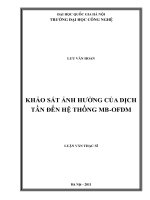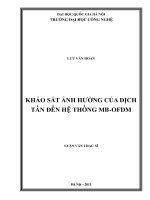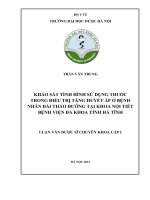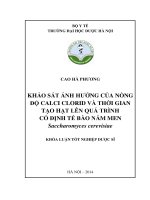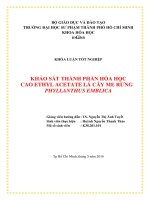Khảo Sát Ảnh Hưởng Của Dịch Tần Đến Hệ Thống Mb Ofdm
Bạn đang xem bản rút gọn của tài liệu. Xem và tải ngay bản đầy đủ của tài liệu tại đây (469.26 KB, 6 trang )
ĐA
̣
I HO
̣
C QUÔ
́
C GIA HA
̀
NÔ
̣
I
TRƯƠ
̀
NG ĐA
̣
I HO
̣
C CÔNG NGHÊ
̣
LƯU VĂN HOAN
KHO ST NH HƯNG CA DCH
TÂ
̀
N ĐÊ
́
N HÊ
̣
THÔ
́
NG MB-OFDM
LUÂ
̣
N VĂN THA
̣
C SI
̃
H Ni - 2011
-OFDM
2011
n :
-OFDM
:
:
:
- 2011
iv
MC LC
i
ii
T iii
iv
vi
viii
ix
x
CHƯƠNG 1: GIƠ
́
I THIÊ
̣
U
1.1.
- 1 -
1.1.1.
- 1 -
1.1.2. - 1 -
1.1.3. - 4 -
1.2. - 5 -
1.3. - 5 -
1.4.
- 6 -
CHƯƠNG 2: HÊ
̣
THÔ
́
NG MB-OFDM
2.1.
-OFDM - 7 -
2.1.1.
- 7 -
2.1.2.
- 8 -
2.1.2.1.
- 9 -
2.1.2.2. 10 -
2.2. 12 -
2.3.
14 -
2.4.
-OFDM 17 -
2.4.1. 18 -
2.4.2. 18 -
2.5.
-OFDM
20 -
2.6. -OFDM 24 -
2.6.1. 30 -
2.6.2. 31 -
v
CHƯƠNG 3: ƯC LƯNG DCH TN TRONG H THNG MB-OFDM
3.1.
35 -
3.2.
39 -
3.3. 47 -
3.4. 52 -
CHƯƠNG 4: KÊ
́
T LUÂ
̣
N V HƯNG NGHIÊN CU TIÊ
́
P THEO
4.1.
54 -
4.2.
55 -
4.2.1. 55 -
4.2.2. MIMO Multiband OFDM 55 -
- 56 -
: g MB-OFDM - 58 -
Kho st nh hưng ca dch tn đn h thng hp kênh phân tn s
trư
̣
c giao đa da
̉
i (MB-OFDM)
,
,
TS Ngu
,
Từ khóa – UWB, OFDM, MB-OFDM, Carrier Frequency Offset.
-
q-368
(WPAN),
UWB
3100 10600 MHz,
480
.
I.
I
U
14
(subband),
528
MHz.
1 trong 6
.
1
.
II. MÔ NH
NG MB-OFDM
-
.
-
(TFC)
y sang
.
-
802.15.3
.
(CFO)
,
(ICI)
.
III.
T N C
NG CH
N
2
.
(do CFO gây ra)
2
.
IV.
T MÔ NG
T
N
K
5 mô
AWGN, CM1 CM4, c
,
,
.
,
(ICI) (
CFO,
).
,
.
1
, trên kênh CM4 .
H
.
, ,
(= 0.04 %)
.
,
.
TÀI THAM
[1] W. Pam Siriwongpairat, K. J. Ray Liu, Ultra-Wideband
Communications Systems - Multiband OFDM Approach,
John Wiley & Sons, Inc, 2008.
[2] Paul H. Moose, A Technique for Orthogonal Frequency
Division Multiplexing Frequency Offset Correction, IEEE
Transactions on Communications, Vol. 42, No. 10, October
1994, trang 2908 2914.
[3] Timothy M. Schmidl, Donald C. Cox, Robust
Frequency and Timing Synchronization for OFDM, IEEE
Transactions on Communications, Vol. 45, No. 12,
December 1997, trang 1613 1621.
[4] Chin Wee Yak, Zhongding Lei, Tjeng Thiang Tjhung,
Maximum likelihood frequency offset estimation and
Cramer Rao bound for ultra-wideband (UWB) multi-
band OFDM systems, IEEE Vehicular Technology
Conference, VTC 2006 Spring, 7-10 May 2006, trang 1929
1934.
[5] B. D. Sahu, Debarati Sen, R. V. Raja Kumar and Saswat
Chakrabarti, A Frequency Offset Estimation Scheme for
OFDM Based UWB Systems, 2006 IEEE Region 10
Technical Conference (IEEE TECON), 14-17 Nov. 2006,
HongKong, trang 1 - 4.
Studying the efffects of frequency offset on multiband orthogonal
frequency division multiplexing (MB-OFDM) systems
Luu Van Hoan
Electronics Engineering, Electronics and
Telecommunications Technology
Faculty of Electronics and Telecommunications
Dr Nguyen Thanh Hieu
Department of Wireless Communications, Faculty of
Electronics and Telecommunications
University of Engineering and Technology
Keywords – UWB, OFDM, MB-OFDM, Carrier Frequency Offset.
The MB-OFDM systems is standardised by
ECMA-368 standard for wireless personal area
networks (WPAN) operating at short ranges and
high data rates. The systems use all of or a part of
the UWB spectrum from 3100 MHz to 10600
MHz. At present, the system support data rates
upto 480 Mbps and so on.
I. INTRODUCTION
The UWB spectrum is diveded into 14 subbands,
each with a bandwidth of 528 MHz. At least one
of the band groups shall be supported. This
standard specifies a Multiband Orthogonal
Frequency Division Modulation (MB-OFDM)
scheme to transmit information.
II. MODEL OF THE MB-OFDM SYSTEM
The structures of the transmiter and receiver of
the MB-OFDM systems is the same to the one of
normal OFDM systems. The primary difference is
that the MB-OFDM use the time-frequency code
(TFC) to hop between subbands from this symbol
to next symbol.
The UWB standard channel models specified
in the IEEE 802.15.3a are derived froum the
Saleh-Valezuela (S-V) model with some minor
modifications due to clustering phenomenon.
Carrier frequency offset (CFO) causes
intercarrier interference (ICI) froum other
subcarrier which are now no longer orthogonal
with each other.
III. THE FREQUENCY OFFSET
ESTIMATION SCHEME
The phase of the correlation of two symbol which
are in packet/frame synchronization part of each
packet consist of the information about CFO. The
algorithm derives its estimates based on phase
differences in the received subcarrier signals of
several successive symbol in the preamble. This
thesis consider the same CFOs and the same
channel responses in different bands.
IV. SIMULATION RESULTS AND
CONCLUSION
With CFO, but not compensating, we can see that
as the CFO increases, the BER also increases.
The reason is that SNR at the receiver decreases,
because the signal after demodulation has ICI.
The performance of system is improved
significantly when CFO is compesnsated at
receiver. When CFO is so small, the accuracy of
the CFO estimation is not good.
REFERENCES
[1] W. Pam Siriwongpairat, K. J. Ray Liu, Ultra-Wideband
Communications Systems - Multiband OFDM Approach,
John Wiley & Sons, Inc, 2008.
[2] Paul H. Moose, A Technique for Orthogonal Frequency
Division Multiplexing Frequency Offset Correction, IEEE
Transactions on Communications, Vol. 42, No. 10, October
1994, pages 2908 2914.
[3] Timothy M. Schmidl, Donald C. Cox, Robust
Frequency and Timing Synchronization for OFDM, IEEE
Transactions on Communications, Vol. 45, No. 12,
December 1997, pages 1613 1621.
[4] Chin Wee Yak, Zhongding Lei, Tjeng Thiang Tjhung,
Maximum likelihood frequency offset estimation and
Cramer Rao bound for ultra-wideband (UWB) multi-
band OFDM systems, IEEE Vehicular Technology
Conference, VTC 2006 Spring, 7-10 May 2006, pages 1929
1934.
[5] B. D. Sahu, Debarati Sen, R. V. Raja Kumar and Saswat
Chakrabarti, A Frequency Offset Estimation Scheme for
OFDM Based UWB Systems, 2006 IEEE Region 10
Technical Conference (IEEE TECON), 14-17 Nov. 2006,
HongKong, pages 1 - 4.

